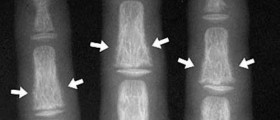
Introduction
Hypercalcemia is a medical condition characterized byelevated amounts of calcium in the human body. It is usually triggered by suchfactors as primary hyperthyroidism and malignancy. There are also certain othercauses but they are usually not taken into consideration before theaforementioned medical conditions get ruled out. Acute hypercalcemia is amedical condition with symptoms and signs which occur only after serum calciumreaches a value of 14 mg/dL or more. Hypercalcemic crisis is associated withthese signs and symptoms and it can be resolved by reducing the levels ofcalcium in the body. The normal range of levels of serum calcium in an adulthuman body is somewhere between 8.7 and 10.4 md/dL. In children, these levelsmay sometimes be slightly higher. 50% of calcium is in physiologic active formand is actually ionized. 40 percent of calcium gets bound to proteins, whilethe remaining 10 percent of calcium gets complexed to anions.
Pathophysiology
The reference range of plasma calcium is maintained byrelations of calcitonin, calcitriol and parathyroid hormone, which are knownfor acting in the small intestine, the kidneys and the bones. The human bodyingests calcium by means of the small intestine, and once all the processes areover, it gets excreted through the kidneys. Bones serve a purpose of storingthe supplies of calcium. A feedback loop controls the entire aforementionedprocess and all the hormones respond individually in order to decrease orincrease the concentration of the serum calcium, according to the needs of thebody. Once the normal calcium regulation system gets overwhelmed by calcitriol,excess amounts of PTH or some other factors, hypercalcemia usually getsdeveloped as a result of all that. There are numerous disorders which cantrigger hypercalcemia and all causes can be divided into PTH-mediatedhypercalcemia and non-PTH mediated hypercalcemia. One of the possible causes isprimary hyperparathyroidism which is characterized by increased amounts ofintestinal calcium absorption. All that leads to increased filtration ofcalcium in the kidneys, and there are actually lower than normal amounts ofcalcium which get excreted.Hypercalcemia associated with malignancy may resultfrom lung cancer, breast cancer, multiple myeloma and it is one of the non-PTHmediated instances of the disease. High levels of the hormone called calcitriolaccompanied by granulomatous disorders may occur in those people who sufferfrom certain other sorts of medical conditions such as histoplasmosis,coccidioidomycosis, leprosy, tuberculosis, berylliosis, sarcoidosis and severalothers.

















Your thoughts on this
Loading...